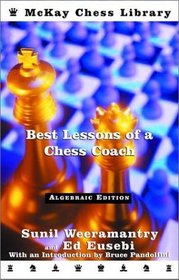From the back cover.
Master Sunil Weermantry is FIDE Master and one of the most successful chess coaches in the country. He has served as a coach for the U.S. team in 3 World Youth Chess Championships and over 30 individual and team champions in National Scholastic Championships. Best Lessons of a Chess Coach consists of ten lessons given by Sunil in his scholastic programs. Questions are posed and answered, instructive alternatives are explored.
The 10 lessons
1. Outpost square. space advantage in the center, building the attack
2.Advanced outpost; controlling the pawn center; the isolated pawn; flank attacks; improving piece placement
3. Weak color complexes; hyper modern systems; longterm weaknesses; space count;
4. weak squares around castled king; broad center vs fianchetto; breaking a pawn chain; attacking the central dark squares; decoy sacrifices; interference
5. controlling light squares; completing development; rook lift; Xray defense; destructive sacrifice; the seventh rank.
6.Initiative; control of key square; piece coordination; king in the center; destructive sacrifece; queen/knight coordination.
7. Sacrifice for initiative; playing against doubled pawns; space advantage in a sector; shifing the focus of the attack.
8. Material imbalance and compensation; rapid mobilization;
9. Making a middle game plan; pawn islands; coordinating rooks; choosing between two courses of action.
10. Attack and defense on squares of a color;weak color complex; pawn sacrifece for structural advantage; reorganizing the attack; square clearance.
Master Sunil Weermantry is FIDE Master and one of the most successful chess coaches in the country. He has served as a coach for the U.S. team in 3 World Youth Chess Championships and over 30 individual and team champions in National Scholastic Championships. Best Lessons of a Chess Coach consists of ten lessons given by Sunil in his scholastic programs. Questions are posed and answered, instructive alternatives are explored.
The 10 lessons
1. Outpost square. space advantage in the center, building the attack
2.Advanced outpost; controlling the pawn center; the isolated pawn; flank attacks; improving piece placement
3. Weak color complexes; hyper modern systems; longterm weaknesses; space count;
4. weak squares around castled king; broad center vs fianchetto; breaking a pawn chain; attacking the central dark squares; decoy sacrifices; interference
5. controlling light squares; completing development; rook lift; Xray defense; destructive sacrifice; the seventh rank.
6.Initiative; control of key square; piece coordination; king in the center; destructive sacrifece; queen/knight coordination.
7. Sacrifice for initiative; playing against doubled pawns; space advantage in a sector; shifing the focus of the attack.
8. Material imbalance and compensation; rapid mobilization;
9. Making a middle game plan; pawn islands; coordinating rooks; choosing between two courses of action.
10. Attack and defense on squares of a color;weak color complex; pawn sacrifece for structural advantage; reorganizing the attack; square clearance.




